
Contents
RRH Index
Extreme Dilute
Syrian Hamsters
Description
History
Genetics
Breeding
Experimental Proofs of
Gene Character and
Transmission
Albinism
ED Photo Gallery
Recessive Dappled
Syrian Hamsters
Description
History
Genetics
Breeding
Experimental Proofs of
Gene Character and
Transmission
Comparison to Other
Patterns
Testing for Allelism with
Dominant Spot
RD Photo Gallery
Working on Type
Syrian Hamster
Genetics
Contact
|
Recessive Dappled Syrian Hamsters
Frequently, carriers of this gene are noted to have increased ventral white markings consisting of a large belly splotch and chest patch. In December of 1996 a breeder from Spice Teddybear Hamstery in Delaware brought a patterned Syrian hamster back to the U.S. from Estonia. She believed it to be a Banded Dominant Spot and so was puzzled when the progeny did not conform to what she expected from a hamster with two dominant pattern genes. Selective inbreeding yielded either unpatterned hamsters or ones with the same patterning as the original. The pattern did not split itself to produce separate Banded or Dominant Spot hamsters, suggesting that it was determined by a single gene. Although methodical crosses to prove the nature of the pattern's genetics were not done at the time, Spice Teddybear and other area breeders came to believe that a new recessive pattern gene was responsible. They called it "Wide Banded."
In May 2003 we received email from Russia documenting that Recessive Dappled hamsters exist and are relatively common there. They do not have Dominant Spot Syrians, eliminating the possibility of the Banded/Dominant Spot combination. The pattern transmits recessively. Previous to learning about the work done here distinguishing the pattern, it was thought that it might represent a poor variaton of Banded or even an incomplete Dark Eared White (in the Cream RDs where nearly all of the color is facial). As with the line in the U.S., the pattern is consistent in its features except for the absolute amount of hindquarter coloring. At right are two photos of Ronia, a Longhair Golden Recessive Dappled female. Ronia earned Best in Show in the first Moscow Rodent Show. Until recently, all Recessive Dappled hamsters could be traced to origins in or near Russia. Then, in 2006, what is believed to be a second de novo Recessive Dappled mutation was identified at Holmden Hill Haven in Ohio. Hamsters manifesting this pattern and all of its genetic characteristics appeared in several litters.These litters could all be traced to the same female. This female was bred solely from lines originating without exception in a region where Recessive Dappled is unknown. Her progenitors showed no sign of having the gene so she in all likelihood harbored a new mutation. The River Road Hamstery acquired from these lines an unpatterned Golden male with a "Wide Banded" dam. Breeding was planned in conjunction with Spice Teddybear Hamstery to delineate the transmission of the pattern. Complete proofs can be found at Experimental Proofs of Gene Character and Transmission. Beyond a doubt, this pattern is indeed generated by a single-locus completely recessive gene. It was proven that this gene is not an allele of the Dominant Spot locus, and the two pattern loci probably are not resident on the same chromosome, that is, they are not linked. As the work proceeded and the pattern was examined in many hamsters, there was reconsideration of its name. Spice Teddybear decided that "Recessive Dappled" incorporated both the mode of transmission (in an important contrast to the other common pattern genes) and the quality of the coloration on the rear of the animal. It was given the symbol rd, with Rd designating the wild type.Breeding for Recessive Dappled follows the same genetic rules as for any other recessive gene. Since two copies are required for the pattern to be evident, one must come from each parent, meaning that both parents must be either Recessive Dappled or carriers. A Recessive Dappled hamster should be bred to another Recessive Dappled or to an unpatterned hamster. Mixing the pattern with Banded, Dominant Spot or Roan/White Bellied is bound to generate confusion and obscure the true pattern.
|

No part of this website may be reproduced in any form or by any means
without the prior written consent of the owner.
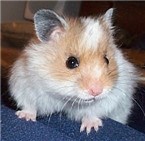 Recessive Dappled is a pattern of white on an otherwise colored hamster. The colored areas are
not modified by the pattern genes, nor are the eyes and ears which are the same as for an unpatterned animal of the same color. Facial coloration is quite distinctive with almost no variation.
The color covers the face laterally to the jaw line. It extends to and includes the ears, ending abruptly just behind them. The ear areas are separated by white, and this break
extends forward to form a blaze, widening slightly before it tapers, usually ending above the nose. The nape and shoulders are pure white with no colored hairs. This large white section may occupy the shoulder level of the body or may go back nearly to the tail.
Recessive Dappled is a pattern of white on an otherwise colored hamster. The colored areas are
not modified by the pattern genes, nor are the eyes and ears which are the same as for an unpatterned animal of the same color. Facial coloration is quite distinctive with almost no variation.
The color covers the face laterally to the jaw line. It extends to and includes the ears, ending abruptly just behind them. The ear areas are separated by white, and this break
extends forward to form a blaze, widening slightly before it tapers, usually ending above the nose. The nape and shoulders are pure white with no colored hairs. This large white section may occupy the shoulder level of the body or may go back nearly to the tail. 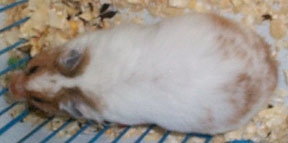 The rear colored area consists of poorly-defined spots or
splotches with white and color being approximately equal. The entire ventral surface is white with no spotting. Recessive Dappled may be seen with any color or coat type.
The rear colored area consists of poorly-defined spots or
splotches with white and color being approximately equal. The entire ventral surface is white with no spotting. Recessive Dappled may be seen with any color or coat type.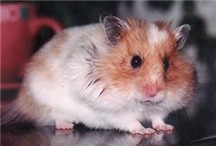
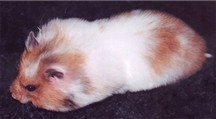
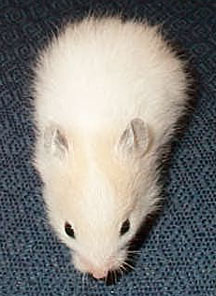 Color and coat type are pertinent, as well. With so much white, only strong, dark colors provide enough
contrast to be attractive. The original lines were mostly Golden and Umbrous Golden with an occasional Cinnamon. Other colors have since been introduced. Recessive Dappled Cream and
Recessive Dappled Extreme Dilute have inadvertently occurred and are regarded as undesirable. The original lines were exclusively longhaired, and this continues to be the case. It is
thought that the pattern would show more clearly on a shorthaired hamster, but this would be a personal preference.
Color and coat type are pertinent, as well. With so much white, only strong, dark colors provide enough
contrast to be attractive. The original lines were mostly Golden and Umbrous Golden with an occasional Cinnamon. Other colors have since been introduced. Recessive Dappled Cream and
Recessive Dappled Extreme Dilute have inadvertently occurred and are regarded as undesirable. The original lines were exclusively longhaired, and this continues to be the case. It is
thought that the pattern would show more clearly on a shorthaired hamster, but this would be a personal preference.